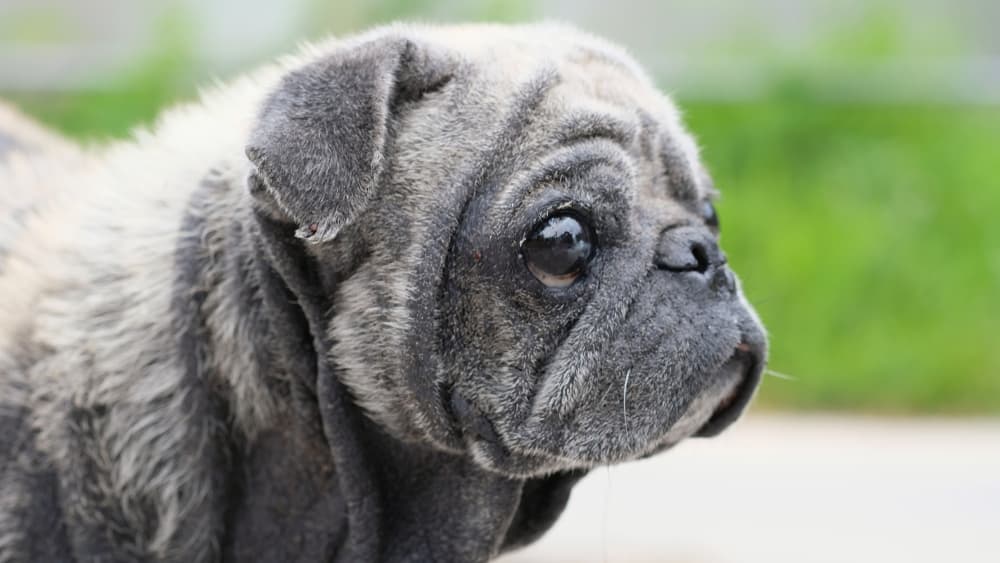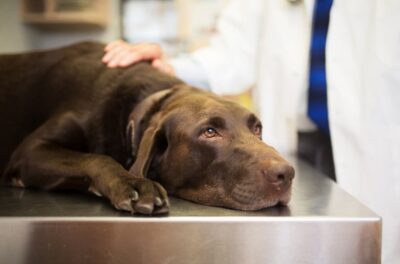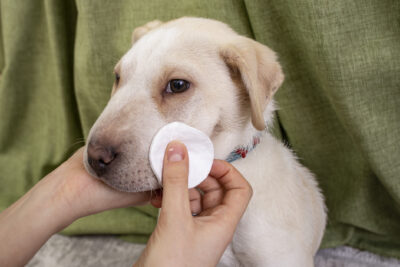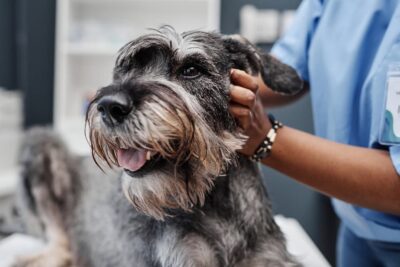Seborrhea in Dogs

Overview
- Seborrhea in dogs is either an inherited disorder or is the result of an underlying problem.
- Seborrhea looks like excessive dandruff and may also make the skin and hair greasy.
- Dogs with seborrhea also struggle with skin infections.
- Treatment usually includes a medicated shampoo as the core medicine.
- Regular brushing, bathing, and omega 3 fatty acids can help mild cases of seborrhea.
In humans, seborrhea is an inflammatory condition that results in dandruff and scaly, red patches of skin.
In contrast, seborrhea in dogs is either an inherited disorder or is the result of an underlying problem, such as hormonal conditions, external parasites, or allergies. In either case, seborrhea in dogs can show up as excessive scaliness of the skin or dandruff, greasy skin and hair, and/or inflamed skin or skin infections.
What is Seborrhea in Dogs?
Seborrhea in dogs occurs when a dog has a cornification disorder of the outer layer of skin, nails, or hair follicles. Skin is constantly being shed, and new skin cells are created by the process of keratinization, where the outermost layer of skin is replaced by keratin.
If a dog has seborrhea, the process of making new skin cells is compromised, resulting in the signs of seborrhea. Seborrhea also affects the sebaceous glands in the skin, causing affected dogs to produce excessive amounts of skin oil, otherwise known as sebum.
Most commonly, seborrhea looks like excessive dandruff or flaking pieces of skin and may also make the skin and hair greasy. Dogs with seborrhea also struggle with skin infections because their abnormal skin creates an ideal breeding ground for yeast and bacteria. Red skin, itching, hair loss, and skin odor are all signs of infected skin.
Symptoms of Seborrhea in Dogs

Signs of seborrhea can range from mild dandruff to severely infected skin, can clog hair follicles, and cause hair loss. Seborrhea affects the parts of the skin that have the most sebaceous glands, including the back, the face, and flanks. Skin folds can also become affected.
Your dog may be suffering from seborrhea if she exhibits the following signs:
- Excessive dandruff, flaking skin, crusts, or scale noted down the back of your dog, on your dog’s bedding, or other areas where your dog lies down
- Greasy skin and hair
- Pimples (sign of infection)
- Small bumps
- Red skin
- Hair loss
- Skin odor
- Darkened, thickened skin
In dogs, seborrhea is most often a secondary problem to another underlying problem, such as hypothyroidism or allergies, and dogs may have additional signs related to the underlying problem.
Signs of an underlying disorder may include:
- Excessive urination
- Excessive drinking
- Heat-seeking behavior
- Changes in appetite
- Lethargy
- Weight loss or gain
- Abnormal estrus cycles in intact female dogs
If you notice these signs in your dog with or without the signs of seborrhea, schedule an appointment with a veterinarian for a check up as soon as possible.
How Do Dogs Get Seborrhea?

Seborrhea in dogs is either a primary problem or a secondary problem to another underlying condition. In dogs, seborrhea is usually secondary to other skin or medical conditions, such as skin infections, stress, hormonal conditions, or obesity. A primary diagnosis of seborrhea is only reached if all other conditions are ruled out.
Primary seborrhea in dogs is an inherited, genetic disease, and is most commonly seen in Cocker Spaniels, Basset Hounds, Westies (West Highland White Terriers), English Springer Spaniels, Golden Retrievers, Labrador Retrievers, German Shepherds, and Dachshunds. The parents are usually affected, and the disease is first noted when dogs less than 2 years of age.
In contrast, secondary seborrhea can be seen in any age of dog, and there are no breed predilections.
The most common causes of secondary seborrhea are allergies, external parasites, and hormonal conditions. Allergies and external parasites are more common in dogs less than five years of age, hormonal conditions are more likely if the dog is older than 5. If a dog is very itchy, then external parasites such as fleas or mites or allergies are more likely, and if a dog isn’t itchy, then a hormonal condition is more likely.
Possible causes of secondary seborrhea in dogs include:
- Flea, food, or environmental allergies (atopy)
- Fleas, ticks, or mites
- Fungal skin infections (like yeast infections)
- Bacterial skin infections
- Poor diet
- Internal parasites
- Hormonal conditions, such as hypothyroidism or Cushing’s syndrome (hyperadrenocorticism)
- Inability to groom properly due to obesity or other musculoskeletal disorders
- Rapid temperature or humidity changes
- Stress
Diagnosing Seborrhea in Dogs

Diagnosis of seborrhea requires a physical examination by a veterinarian that not only includes a comprehensive examination of the skin, but also all the rest of the body.
Remember—most cases of seborrhea in dogs are secondary to another underlying problem, and your dog’s physical exam may provide clues that will help your veterinarian figure out what that is. Your veterinarian will also need a history from the dog’s primary caregiver.
Examination of the skin includes documenting the presence, type, severity, and location of skin abnormalities. Hair loss, odor, greasiness, scaling, redness, bumps are all noted in the veterinary record.
Depending on what your veterinarian finds on physical exam, skin tests may be recommended for your dog. These tests could include skin scraping and microscopic exam, bacterial or fungal cultures, combing for fleas, and/or a skin biopsy.
If your veterinarian suspects an underlying disease, then additional tests, such as blood and urine testing or allergy testing, could be recommended. Follow all recommendations from your veterinarian.
Seborrhea in Dogs Treatment
Occasionally, if seborrhea is due to temperature changes or stress, it may resolve on its own. Otherwise, treatment of seborrhea in dogs requires treating the underlying condition, treating any skin infections, keeping your dog comfortable, and treating the seborrhea itself.
A veterinarian will usually prescribe a medicated shampoo as the core medicine. Even though washing a dog with medicated shampoo can be difficult (you do have to let them soak in the shampoo for 5-10 minutes before rinsing), it is usually the easiest, most effective treatment available, and can often resolve seborrhea without any other treatment required. Medicated shampoos reduce flaking and itching, fight infections, and help the skin heal.
Keratolytic shampoos are designed to remove excess scale and dead skin and soften the skin. These shampoos can contain tar, salicylic acid, sulfur, fatty acids, selenium sulfide, benzoyl peroxide, and/or propylene glycol. Dogs being treated with keratolytic shampoo may look worse before they look better since these products can remove built up dead skin that can get caught in fur.
Zinc gluconate shampoo also fights seborrhea by decreasing skin oil (sebum) production.
Phytosphingosine (PS) is another ingredient you might see in a medicated shampoo. PS is naturally present in skin as a component of ceramides. Ceramides are part of the skin’s defense barrier, and are responsible for the outermost layer of the skin sticking together, controlling resident bacteria on the skin, and keeping the skin properly moisturized.
Shampoos might also contain an antifungal component (i.e. climbazole) or antibacterial component (i.e. chlorhexidine) to help combat any concurrent fungal and/or bacterial component.
In addition to medicated shampoos, your veterinarian may prescribe medicated lotions, spray-ons or leave-ons that may also have these ingredients. Your veterinarian may also recommend a conditioner or leave-on product that has moisturizing or emollient properties to soften and soothe dry, irritated skin.
In some cases, oral medication may be prescribed. Cyclosporine, omega-3 fatty acids, zinc, vitamin D, vitamin A, steroids, and retinoids have all been prescribed with varying levels of success.
If the skin is infected, antibiotics and/or antifungal medications will be prescribed. These medications are prescribed in oral, injectable, and topical forms, depending on the individual case.
If your dog has an underlying disorder that is causing seborrhea, then you aren’t done! In order to eliminate the seborrhea and help your dog be healthy, the underlying condition must also be treated. If your dog has primary seborrhea with no underlying problems, treatment is aimed at managing seborrhea, not curing it.
Home Remedies for Seborrhea in Dogs
Most dogs that are struggling with mild seborrhea can benefit from home remedies including:
- Supplementing their food with omega 3 fatty acids (check with your veterinarian for a dosage recommendation)
- Regular hair brushing
- Regular baths with oatmeal shampoo to reduce itchy and scaling
If seborrhea does not resolve with these home remedies, schedule an appointment with your local veterinarian.
General Cost of Treatment for Seborrhea in Dogs
If treating primary seborrhea, cost can range from $150-$300, depending on the size of your dog and where you live. This cost would include a physical exam, skin testing, medication, and/or shampoo.
If treating secondary seborrhea, treatment costs will include treating the skin problems (as mentioned above), as well as diagnosing and treating the underlying cause. This could cost an additional $100-$500 for diagnosis and initial treatment of the underlying disease, with potential for long-term expenses for medications.
If the case is more severe or requires additional testing, then the cost goes up quickly.
How to Prevent Seborrhea in Dogs

While some cases of seborrhea are genetic and cannot be prevented, there are some things pet parents can do to help their dogs from developing seborrhea.
Make sure your dog is eating a high quality, complete and balanced diet that is rich in omega-3 fatty acids, or give your dog a fish oil supplement. Always ask your veterinarian before giving your dog supplements.
Take your dog in for regular veterinary check-ups to make sure your dog doesn’t have underlying conditions that could contribute to seborrhea.
If your dog is genetically predisposed to seborrhea, follow your veterinarian’s recommendations and use all medications as prescribed to minimize the problems associated with seborrhea.
Related Conditions
- Bacterial Skin Infections (Pyoderma)
- Yeast Overgrowth (Fungal Skin Infection)
- Hypothyroidism
- Cushing’s Syndrome (Hyperadrenocorticism)
- Skin Allergies
- Fleas
- Scabies









